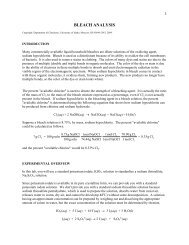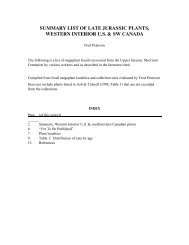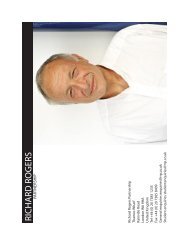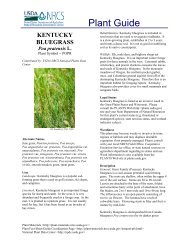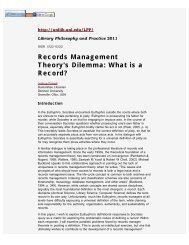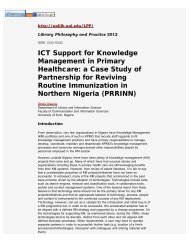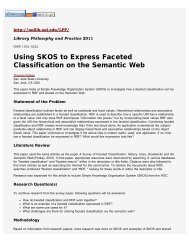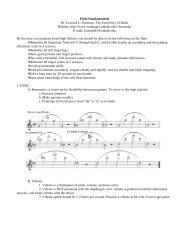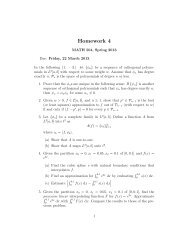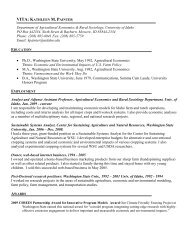Value-added Utilization of Crude Glycerol from Biodiesel Production ...
Value-added Utilization of Crude Glycerol from Biodiesel Production ...
Value-added Utilization of Crude Glycerol from Biodiesel Production ...
You also want an ePaper? Increase the reach of your titles
YUMPU automatically turns print PDFs into web optimized ePapers that Google loves.
The speed <strong>of</strong> the stirrer was set constant at 100 rpm throughout the reaction. All the catalysts used in this<br />
study were reduced prior to the reaction in the same reactor by passing a stream <strong>of</strong> hydrogen over the<br />
catalyst bed at 300°C for 4 h. Copper-chromite catalyst was the most effective catalyst for the<br />
hydrogenolysis <strong>of</strong> glycerol to. The yield <strong>of</strong> 73% was achieved.<br />
Dihydroxyacetone<br />
Dihydroxyacetone is a simple three-carbon sugar, non-toxic in nature. It is used in cosmetics industries as<br />
a tanning agent (Bauer et al., 2005). Garcia et al. (1994) investigated the liquid-phase oxidation <strong>of</strong><br />
glycerol with air on platinum catalysts at different pH. Oxidation <strong>of</strong> aqueous solutions <strong>of</strong> glycerol were<br />
carried out at atmospheric pressure in a thermostated glass reactor <strong>of</strong> 500 mL equipped with a stirrer, a<br />
gas supply system, an oxygen electrode and a pH electrode. The catalyst was suspended in 300 mL <strong>of</strong><br />
water under a nitrogen atmosphere and the suspension was heated to 333 K whilst stirring continuously<br />
at 1200 rpm. <strong>Glycerol</strong> was then <strong>added</strong> and, following a delay <strong>of</strong> 10 min, air was bubbled through the<br />
slurry at 0.75 mL/min. The initial concentration <strong>of</strong> the aqueous glycerol solution was 1 mol/L. The reaction<br />
medium was maintained at a constant pH by addition a 30% sodium hydroxide solution using a pump<br />
controlled by a pH meter. The selectivity to glyceric acid was 70% at 100% conversion on Pd/C at pH 11.<br />
On Pt/C catalyst, glyceric acid was the main product with 55% selectivity. They found that deposition <strong>of</strong><br />
bismuth on platinum particles orientates the selectivity towards the oxidation <strong>of</strong> the secondary hydroxyl<br />
group to yield dihydroxyacetone with a selectivity <strong>of</strong> 50% at 70% conversion. Kimura (2001) catalytically<br />
prepared dihydroxyacetone by selective oxidation <strong>of</strong> glycerol. Using bismuth in platinum with weight ratio<br />
<strong>of</strong> 0.2 gave dihydroxyacetone selectivity to 80%. Bismuth adatoms controlled the glycerol orientation<br />
towards dihydroxyacetone formation functioning as site blockers on Pt (111). They found that the use <strong>of</strong><br />
fixed-bed reactor increases the conversion and yield. Moreover the catalytic method had higher<br />
productivity than the conventional fermentation process. Svitel and Sturdík. (1994) produced<br />
dihydroxyacetone by the strain gluconobacter oxydans CCM 1783 in batch cultures with gassing by<br />
air/oxygen. They studied the influence <strong>of</strong> the oxygen concentration and pH <strong>of</strong> the fermentation medium on<br />
product yield. According to them the product yield decreases at acidic pH and below oxygen<br />
concentrations <strong>of</strong> 4 × 10 -4 mol/L. The yields <strong>of</strong> 87-94% were obtained. Usage <strong>of</strong> air decreased yield by 7<br />
% due to the formation <strong>of</strong> glycerate as a by-product in fermentation medium. Boriesa et al. (1991)<br />
determined kinetic parameters during dihydroxyacetone production by Gluconobacter oxydans in batch<br />
culture with different glycerol concentrations with mannitol as a substrate. The fed-batch culture<br />
converted more glycerol than batch culture performed with initial substrate concentration <strong>of</strong> 100 g/L<br />
making the kinetic parameters more optimal. They found that presence <strong>of</strong> dihydroxyacetone exerts an<br />
inhibitory effect on G. oxydans. The rate <strong>of</strong> growth decreases with increasing dihydroxyacetone<br />
concentration, and ceases at a dihydroxyacetone concentration <strong>of</strong> 61 g/L. <strong>Glycerol</strong> oxidation into<br />
dihydroxyacetone is not affected during this period suggesting a decoupling <strong>of</strong> growth and production. At<br />
dihydroxyacetone concentration <strong>of</strong> 108 g/L, the glycerol conversion ceases. Batch growth followed by fedbatch<br />
on glycerol avoids the inhibitory effects and leads to an optimized dihydroxyacetone production<br />
process. Bauer et al. (2005) investigated the influence <strong>of</strong> the product inhibition by dihydroxyacetone on<br />
gluconobacter oxydans for a semi-continuous two-stage repeated-fed-batch process. The bioreactor<br />
system was a combination <strong>of</strong> a laboratory scale bubble column with a height <strong>of</strong> 300 mm and an inner<br />
diameter <strong>of</strong> 100 mm and a laboratory-scale stirred reactor having the same dimensions. The total volume<br />
<strong>of</strong> each reactor was 2 L. The reaction volumes were 1.5 L and 1.47 L for reactor stage 1 and reactor<br />
stage 2, respectively. Both reaction volumes were kept nearly constant during the repeated-fed-batch<br />
experiments by a correctly set concentration <strong>of</strong> the glycerol feed in order to compensate the loss <strong>of</strong> broth<br />
volume due to evaporation. The pH in reactor 1 was controlled at 5.3. The pH in reactor 2 was not<br />
controlled. The temperature was controlled at 30°C. A dihydroxyacetone concentration <strong>of</strong> 80 kg/m 3 was<br />
achieved without any influence <strong>of</strong> product inhibition. The regeneration capability <strong>of</strong> the reversibly product<br />
inhibited culture <strong>from</strong> a laboratory-scale bioreactor system was observed up to a dihydroxyacetone<br />
concentration <strong>of</strong> about 160 kg/m 3 . At higher dihydroxyacetone concentrations, the culture was irreversibly<br />
product inhibited. The reachable maximum final dihydroxyacetone concentration was as high as 220<br />
kg/m 3 . Adlercreutz (1986) studied reaction kinetics for one-step reactions catalyzed by cells immobilized<br />
in calcium alginate spherical beads. He assumed Michaelis-Menten kinetics for a one-substrate reaction<br />
taking into account the external and internal mass transfer <strong>of</strong> the substrate for the immobilized<br />
preparations. The reaction rate was limited by oxygen when glycerol was in excess. Use <strong>of</strong> p-<br />
6




